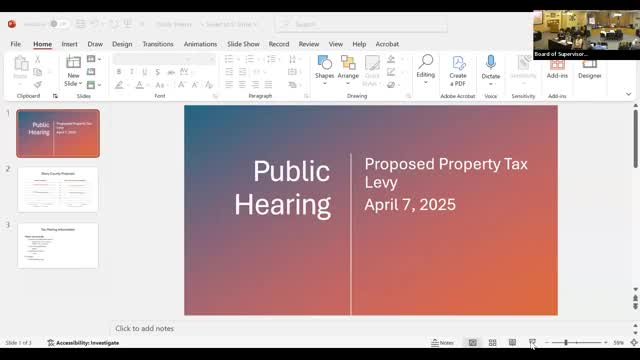Story County proposes tax levy adjustments amid valuation discrepancies
April 09, 2025 | Story County, Iowa
Thanks to Scribe from Workplace AI , all articles about Iowa are free for you to enjoy throughout 2025!

This article was created by AI using a video recording of the meeting. It summarizes the key points discussed, but for full details and context, please refer to the video of the full meeting. Link to Full Meeting
The general supplemental levy is set to decrease by over 38 cents per thousand dollars of assessed value, dropping from 4.415 to 4.03. Similarly, the rural levy will see a reduction of about 8 cents, from $7.29 to $7.21. These adjustments come as part of the county's efforts to manage tax rates amid changing property valuations.
However, the communication sent to residents regarding these changes has raised concerns. The notice, which cost the county approximately $17,000 to distribute, does not provide a complete picture of the overall tax burden. It only includes information from the three largest taxing entities: the school district, the city, and the county. Notably, it assumes a 10% increase in property valuations, a figure that does not reflect the actual 2.29% increase experienced in Story County.
Officials acknowledged that while the mailing is required by state law, it may lead to confusion among taxpayers. The incomplete nature of the information could mislead residents about their actual tax liabilities, as it does not account for additional levies from local townships or other entities, such as fire services.
The meeting also served as a platform for residents to ask questions and seek clarification on the proposed rates and their implications. County officials emphasized the importance of public engagement during these hearings, encouraging residents to participate and voice their concerns.
As Story County moves forward with the budget process, the adjustments to the property tax levy reflect a commitment to transparency and responsiveness to community needs. The next steps will involve further discussions and evaluations to ensure that the final tax rates align with the county's financial goals while considering the impact on residents' daily lives.
Converted from April 7, 2025 Board of Supervisors Public Hearing on FY26 Proposed Property Tax Levy meeting on April 09, 2025
Link to Full Meeting
Comments
View full meeting
This article is based on a recent meeting—watch the full video and explore the complete transcript for deeper insights into the discussion.
View full meeting
